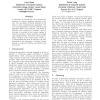Free Online Productivity Tools
i2Speak
i2Symbol
i2OCR
iTex2Img
iWeb2Print
iWeb2Shot
i2Type
iPdf2Split
iPdf2Merge
i2Bopomofo
i2Arabic
i2Style
i2Image
i2PDF
iLatex2Rtf
Sci2ools
IJCAI
1997
1997
Content Ordering in the Generation of Persuasive Discourse
A framework is summarized which supports the planning of natural language argument structure. One key aspect of natural argument is the order in which components are presented. This is in part responsible for both the coherency and persuasive effect of an argument. One means of effecting such ordering is proposed, and an overview is provided of the various classes of ordering heuristics. These heuristics are based upon insights offered by rhetoric texts, psychological research, and a corpus study. Finally, it is demonstrated that such an approach can also contribute to the generation of surface textual features including formatting, punctuation and clue words.
| Added | 01 Nov 2010 |
| Updated | 01 Nov 2010 |
| Type | Conference |
| Year | 1997 |
| Where | IJCAI |
| Authors | Chris Reed, Derek Long |
Comments (0)

